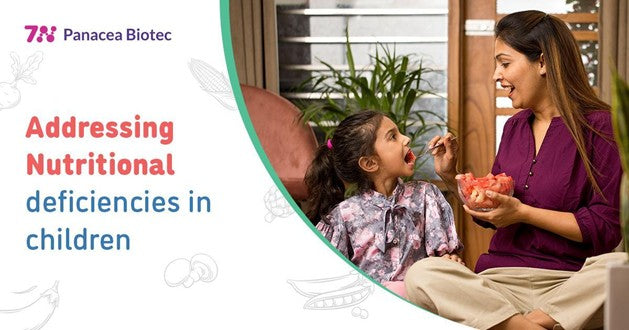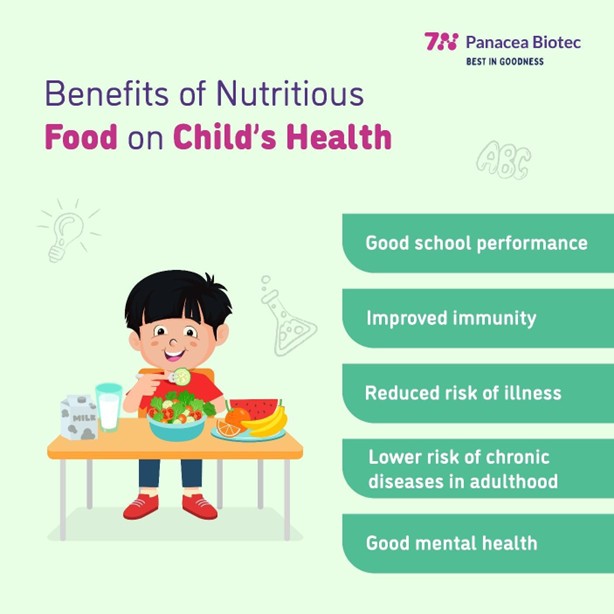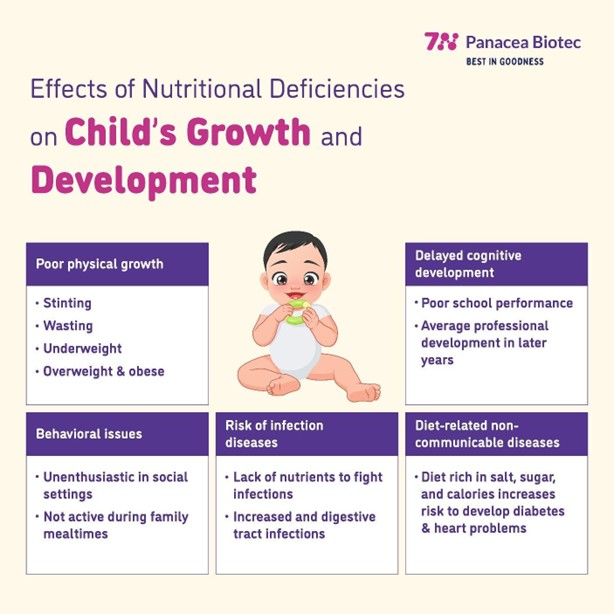Addressing Nutritional deficiencies in children Introduction
Share

Kids will never give up their playtime, so how do you keep their energy levels up all day? The answer is simple - a well-balanced diet packed with the right nutrients.
Nutritious food is a child’s superpower to health and well-being. A nutritious diet provides energy and nourishes the body with the nutrients it needs to work effectively. The benefits of nutritious food span across different areas of children’s overall development: good academic performance, improved immunity, reduced risk of illness, lower risk of chronic diseases in adulthood, improved mental health, the list can go on and on (See Figure 1).1

Introducing the value of the right nutrition to the kid throughout their childhood is critical for the development of lifelong healthy eating habits1
As parents, we always seek the best for our children. So even after all these efforts, what are the possible factors affecting your child’s nutrition goal? The common reasons for nutritional deficiencies in children are certain health conditions, medicines, limited knowledge about nutrition, poverty, and socio-economic factors.2Exposure to advertisements promoting unhealthy diets also influences eating habits and nutrition amongst children.3
With this, nutritional deficiencies in children have become a major health concern. Children are conveniently exposed to various junk foods at an early age.
Pizzas, Burgers, and Ice Creams are like their new best friends. To add more to it, parents’ busy lifestyles and lack of education on the right nutrition have worsened the problem. Did you know? According to the World Health Organization (WHO), “Poor nutrition is a major cause of various health complications in children and contributes to nearly half of deaths among children under five years of age”.4
But what is this fuss about Nutrition Balance? Well, it’s not just a fuss but a critical aspect of your child’s overall growth. The deficiency of essential nutrients comprises the body’s ability to perform its functions correctly. Your child might lose interest in his/her favourite daily activity no matter how much he/she loves going out and having playtime with his/her friends.
They can also have serious consequences on a child’s health and development. In the following sections, we discuss some of the major effects of nutritional deficiencies among children.
Harmful effects of nutritional deficiencies on growth and development in children
The harmful effects of poor nutrition can be seen mainly in the following forms (Figure 2):5
- Poor physical growth
- Delayed cognitive (mental) development
- Behavioural issues
- Risk of infectious diseases
- Diet-related non-communicable diseases

Poor physical growth
Foods with low nutritional value delay children's physical growth. Children may not reach the physical growth milestones appropriate to their age.
Following are the common signs of poor physical growth:
- Stunting (low-height-for-age)
- Wasting (low-weight-for-height)
- Underweight (low-weight-for-age)
- Overweight or and obesity
On the other hand, being overweight or obese is often due to the consumption of calorie-rich and nutrition-deficit foods like soft drinks and processed foods. Children who are overweight or obese are at increased risk of developing diabetes and heart problems.3
Delayed cognitive development
A diet lacking nutrients like zinc, iron, vitamin B12, and omega-3 fatty acids,1 influences brain growth resulting in delayed development of cognitive skills.
The result of poor cognitive development (process of thinking and reasoning) is often reflected in academic performance. If not addressed, these issues may continue in their adulthood and can have implications on their professional development and living standards.6
Behavioural issues
If children often seem sad or unenthusiastic, their diet might be a factor to consider. Scientific evidence suggests that children having food with poor nutritional value are socially inactive or unhappy. They often show a lack of interest in social settings compared to well-nourished children. Also, such children may not be active even during family mealtimes, reducing their chances of having sufficient quantity and quality of food.6
Risk of infectious diseases
Sufficient stores of proteins, vitamins, and minerals derived from a healthy diet play a crucial role in boosting a child’s immune system. On the contrary, a child with nutritional deficiency becomes an easy target for frequent infections. For example, Vitamin A deficiency can damage the mucus-producing cells that protect the respiratory and digestive systems. Normally, mucus acts as a barrier, helping remove germs and prevent infections. Without this protective layer, children become more likely to catch bacterial and protozoan infections, leading to problems like diarrhoea, weight loss, and anaemia.7
Diet-related non-communicable diseases
Due to diet-poor nutrition, children are more likely to develop non-communicable diseases such as diabetes, heart disease, cancer, and hypertension.4
Especially, increased consumption of processed foods rich in salt, sugar, and saturated fat fails to provide nourishment to the body. Even street foods in urban areas are found to be high in calories.3 Therefore, frequently eating outside can put a child at risk of several health issues.
From scientific studies, we now know that good eating habits are at the core of a child’s healthy future. Therefore, good dietary habits should be developed at an early age. In the following section, we discuss practical tips to help parents and doctors cultivate better dietary habits in children.
Tips to promote healthy food habits in children
As a parent, you've likely heard plenty of complaints about food from your children: "I don't want to eat this," "Why does it taste so bland?" "It tastes so bad, I won't eat it.", this list is endless.
Making a child choose healthy and nutritious food often comes with its own set of challenges. Parents regularly face difficult times making children eat healthy food. But with the right knowledge and a little clever approach, children can cultivate healthy food habits that help them lead healthy lives. The following tips can be helpful:
Changes to parent’s dietary habits
From a very young age, children learn from their parents and mimic their actions and behaviour.1 Thus, the dietary preferences of parents can have a big impact on how and what children choose. Actions speak louder than words, and therefore, you need to practically showcase to your child the lifestyle they should opt
Parents can always teach their children the value of good nutrition and demonstrate how they can practice healthy eating habits. You can involve your child in fetching some healthy groceries, reading them healthy ingredient labels while picking any item, and cooking altogether.
Figuring out what's stopping people from eating healthy is also super important for making a nutrition plan that works. Lack of access to healthy food, easy availability of processed food, and high cost are some of the common challenges. On the other hand, family support and the physical appearance of healthy food items are shown to facilitate healthy eating habits. Parents and healthcare professionals can work together to identify barriers and address them early.
Plan regular family mealtimes
A family that eats together, stays together! Family mealtimes are ideal for social bonding and establishing a child’s relationship with the foods they eat. Regular family mealtimes help parents to plan the meals and ensure an appropriate nutrient supply in every meal.
Healthcare professionals may seek more information on a family’s routine and suggest regular family mealtimes. They can explain to parents and caregivers, the importance of family mealtimes and having an eating schedule. Based on the nutritional assessment of a child, doctors may recommend certain foods to include in the menu to ensure every nutritional requirement is met.
Not just nutritional value, but family mealtimes also promote children's mental health and long-term healthy eating habits. Research shows that frequent family mealtimes reduce the incidence of disordered eating, depression, and behavioural issues in children. This is possibly due to lower consumption of soft drinks, no use of any electronic devices, and increased and focused eating of fruits and vegetables when dining with parents. 8
Family mealtimes lead to a lower consumption of soft drinks and increased eating of fruits and vegetables
Introduce new foods with the familiar ones
We tend to give up on healthy foods that our kids refuse to eat, even if they're good for them. We know children always prefer comfort and like to eat foods familiar to them. Pressure to eat unfamiliar foods may lead to negative eating experiences, and that’s why we just avoid getting into that struggle. However, parents and doctors can work together on better approaches to introducing new food to children in a systematic approach.
But how can we do that? One of the effective strategies is to introduce a new food with a familiar one. For example, if a child likes to drink milk, introduce a fruit smoothie and encourage him/her to try the smoothie. Or try to add flavour and nutrients to that milk with health supplement drinks like ChilRun®.
Generally, a child’s diet should contain a variety of nutrient-dense foods such as whole grains, legumes, low-fat dairy, lean meat, and fruits and vegetables. Exposure to diverse foods not only improves the consumption of vitamins, nutrients, and fibres but also makes eating an interesting and fun activity.
Doctors may guide parents to introduce fruits and vegetables at an early age. Evidence suggests that early exposure to fruits and vegetables improves their acceptance later in life. While parents may try different approaches, consistency and patience are key. It may take at least 15-20 exposures to a new food before the child may try the new food.1
Limit processed foods
According to the American Academy of Pediatrics (AAP) and the American Dietetic Association (ADA), nutritional issues in children are influenced by the consumption of high-sugar and carbonated beverages. Particularly, soft drinks and other sugary fruit drinks which are energy-dense, can negatively impact the intake of essential nutrients such as vitamins A and C, and minerals like calcium and phosphorus.9,10
This problem can be approached through education on moderate consumption. Parents may emphasize portion control when children like to have beverages and other processed foods. On the other hand, doctors can educate parents on the differences between fruit drinks and fruit juices and strategies to avoid overconsumption. To prevent overconsumption, parents can consider limiting the availability of sugary drinks and processed snacks at home.11
While avoiding processed food completely is not often practical, limiting the portion and frequency is the best strategy. 1
Encourage, do not force
As a parent, we all know how sensitive our kids can be in certain situations and forcing them to do something should always be a last resort. While nutritious food is beneficial to children’s health, forcing them to follow good dietary habits will not help. Research shows that authoritarian parenting is less likely to promote good eating habits.
Instead, parents can develop moderate restriction strategies.8 Being all strict and uptight with your child might not work as planned for you. While prioritizing healthy eating habits, you must always cut them some slack with a few occasional treats to prevent feelings of deprivation and potential overeating.
Parents can discuss their dietary habits with doctors and seek recommendations to gradually reduce unhealthy food items from meals. With every new food introduced, a healthy conversation may be initiated between parents and children on the nutritional value and the benefits the foods offer to health. However, children should be allowed to decide on having the food.11
If you bribe your kid with chocolate to eat their veggies, you're doing it wrong. Don't use rewards or punishments to get them to try new foods. Doctors should suggest parents not use food as a reward or punishment. Such practices only contribute to increased calorie intake instead of helping develop good eating habits. 8
Summary
In conclusion, teaching your child healthy eating habits is a no-brainer. All you need is a little professional help, a few lifestyle changes of your own, and a lot of patience. However, your consideration will positively pay off as good eating habits have long-lasting consequences on the child’s health and future. While this transition is not without challenges, consistent efforts and the right practices can change children’s attitudes toward healthy food. Doctors and parents can work together on actionable approaches to promote healthy eating habits in children.
References
- Melanson KJ. Nutrition Review: Lifestyle Approaches to Promoting Healthy Eating for Children. Am J Lifestyle Med. 2008;2(1):26-29.
- Malnutrition – Causes - NHS. Available at https://www.nhs.uk/conditions/malnutrition/causes/. Accessed on Nov 19, 2024.
- Ahmad R, Akter F, Haque M. Editorial: Diet and nutrition for non-communicable diseases in low and middle-income countries. Front Nutr. 2023;10.
- Fact sheets - Malnutrition. Accessed on November 20, 2024 from https://www.who.int/news-room/fact-sheets/detail/malnutrition.
- Soliman A, et al. Early and Long-term Consequences of Nutritional Stunting: From Childhood to Adulthood. Acta Bio Medica : Atenei Parmensis. 2021;92(1):e2021168.
- Chattopadhyay N, et al. Developmental Outcome in Children with Malnutrition. Journal of Nepal Paediatric Society. 2016;36(2):170-177.
- Rodríguez L, et al. Malnutrition and gastrointestinal and respiratory infections in children: a public health problem. Int J Environ Res Public Health. 2011;8(4):1174-1205.
- Mahmood L, et al. The influence of parental dietary behaviors and practices on children’s eating habits. Nutrients. 2021;13(4).
- Gillis B, et al. Rationale, design, and methods of the HEALTHY study nutrition intervention component. Int J Obes (Lond). 2009;33(Suppl 4):S29.
- Moshfegh AJ, Garceau AO, Parker EA, Clemens JC. Beverage Choices among Children. FSRG Dietary Data Briefs. Published online 2019. Accessed on November 20, 2024 from https://www.ncbi.nlm.nih.gov/books/NBK589292/
- Van Lippevelde W, et al. Associations between home- and family-related factors and fruit juice and soft drink intake among 10- to 12-year-old children. The ENERGY project. Appetite. 2013;61(1):59-65.
